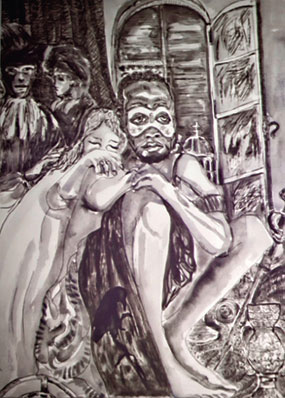Ian Smith Transforms World’s View of Othello

Ian Smith (left) discusses the prints with students Axel Calmet ’14 (center), and Valerie Acheampong ’15.
THE ENDURING LEGACY of Shakespeare’s canon is that each reading yields new discoveries such as the one made by Ian Smith, professor of English, which he describes in “Othello’s Black Handkerchief” in the spring 2013 Shakespeare Quarterly.
Smith challenges the status quo assumption that the handkerchief given by Othello to Desdemona in Othello is white, contending that textual clues in the play indicate that it is black.
“Among critics, the handkerchief has been regarded as a unifying motif for the dramatic action,” says Smith. “Thus changing or challenging our commonly held perceptions about this most famous of all early modern stage properties requires some intellectual adjustment on the part of readers and, hopefully, audiences.”

In this print, Curlee Holton has featured the black handkerchief.
Smith gave a lecture on his findings in the Gendebien Room, Skillman Library. The artist’s book, Othello Re-imagined in Sepia, a collaboration with Curlee Holton, professor and head of art, was on view. The series of 10 prints depict Othello in the context of contemporary issues of race, identity, and culture.
Smith focuses on Othello’s description of the handkerchief as “dyed in mummy,” arguing that “mummy” is a black substance associated with Africa—especially Egypt—and early modern medicine. The handkerchief’s black textile becomes identified with Othello’s body, recalling the early modern stage practice of actors wearing black cloth to mimic black skin when portraying Africans. Also, Smith points out, it is “dyed,” and it would be unusual to dye a material to obtain a white color.
Beyond determining the handkerchief’s true color, the long-held belief that it is white speaks to how cultural conditioning and education have shaped reading practices.
Viewing the play in the context of a white handkerchief may be a subconscious decision, but it is not an entirely innocent one, says Smith. The white handkerchief orients reader interest toward Desdemona, Othello’s Venetian (and white) wife. The black handkerchief reaffirms the play’s interest in the character Othello while forcing readers to question the implications of this alternate reading.
“The critical success of a white handkerchief results in an unstated yet crucial effect of highlighting whiteness at the expense of blackness in ways that appear as natural and inevitable as the selection of the handkerchief’s white color,” explains Smith. “There is nothing natural or inevitable about this shift in racial focus, and one of the goals of my essay is to call attention to the impact of racial habits on critical practice and tradition.”